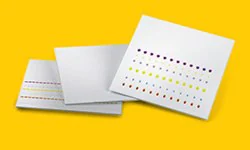Thin Layer Chromatography (TLC)
Analytical Chemistry
Thin Layer Chromatography (TLC)

Thin layer chromatography (TLC) is an affinity-based method used to separate compounds in a mixture. TLC is a highly versatile separation method that is widely used for both qualitative and quantitative sample analysis. TLC can be used to analyze virtually any substance class, including pesticides, steroids, alkaloids, lipids, nucleotides, glycosides, carbohydrates, and fatty acids.
In TLC, the stationary phase is a thin adsorbent material layer, usually silica gel or aluminum oxide, coated onto an inert plate surface, typically glass, plastic, or aluminum. The sample is spotted onto one end of the TLC plate and placed vertically into a closed chamber with an organic solvent (mobile phase). The mobile phase travels up the plate by capillary forces and sample components migrate varying distances based on their differential affinities for the stationary and mobile phases. When the solvent reaches the top of the plate, the plate is removed from the developing chamber and dried. The separated components appear as spots on the plate and the retention factor (Rf) of each component is assessed.
- TLC Process and Principles
- TLC Retention Factor: Rf
- Applications of TLC


